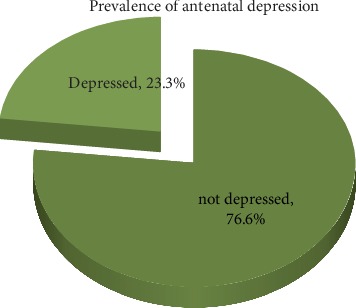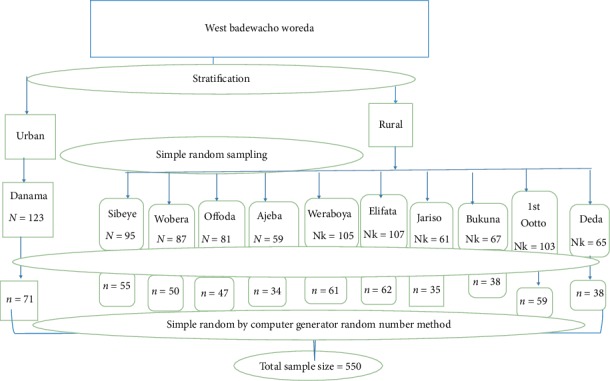Magnitude of Antenatal Depression and Associated Factors among Pregnant Women in West Badewacho Woreda, Hadiyya Zone, South Ethiopia: Community Based Cross Sectional Study.
Q1 Psychology
Depression Research and Treatment
Pub Date : 2020-01-28
eCollection Date: 2020-01-01
DOI:10.1155/2020/2950536
引用次数: 9
Abstract
Background Antenatal depression is prevalent and serious problems that is associated with psychosocial factors, obstetric history, and history of psychiatric illness. Evidence on prevalence and factors associated with antenatal depression at community level is limited in Ethiopia. The aim of this study was assessing the prevalence of antenatal depression and associated factors among pregnant women in West Badewacho Woreda, Hadiyya Zone, South Ethiopia, 2018. Methods A community based cross sectional study was conducted from March 15 to April 12, 2018. To draw a total sample size of 541 pregnant women, multistage sampling technique was used. Pretested semi-structured questionnaire and standardized scale was used to collect data from each study subject. Data were entered and cleaned using Epi-Data version 3.1 and exported to SPSS version 23 for analysis. Bivariate analysis was carried out to see crude association between each independent variable and outcome variable. Odds ratios at 95%CI were computed to measure the strength of the association between the outcome and the independent variables. P-value < 0.05 was considered as statistically significant in multivariate analysis. Results The prevalence of antenatal depression in the study population was 23.3% (CI: 19.8–26.8). Factors significantly associated with antenatal depression were marital status other than married (single, widowed, divorced) [AOR: (2.807; 95%CI: (1.268, 6.227); p-value = 0.042], history of previous depression [AOR: 3.414; 95%CI: (1.154, 12.999); p-value = 0.001] family history of mental illness [AOR: 3.874; 95%CI: (1.653, 7.052); p-value = 0.028], recent violence from intimate partner [AOR: 3.223; 95%CI: (1.359, 7.643); p-value = 0.008], unsatisfactory marital relation [AOR: 7.568; 95%CI: (3.943, 14.523); p-value < 0.001], lack of adequate social support [AOR: 5.491; 95%CI: (2.086, 14.451); p-value < 0.001] and unplanned current pregnancy [AOR: 2.013; 95%CI: (1.025, 3.953); p-value = 0.042]. Conclusion The prevalence of antenatal depression in west Badewacho woreda was high and it is associated with marital status, unplanned current pregnancy, history of previous depression, family history of mental illness, recent violence from intimate partner, poor marital satisfaction level, and poor social support. Improving maternal and child health services and introducing screening for depression as part of routine antenatal assessment to curb antenatal depression should get due attention.


南埃塞俄比亚Hadiyya地区West Badewacho wooreda孕妇产前抑郁程度及相关因素:基于社区的横断面研究
背景:产前抑郁是一种普遍和严重的问题,与社会心理因素、产科史和精神病史有关。在埃塞俄比亚,社区层面关于产前抑郁症患病率和相关因素的证据有限。本研究的目的是评估2018年埃塞俄比亚南部Hadiyya区West Badewacho wooreda孕妇产前抑郁症的患病率及其相关因素。方法:于2018年3月15日至4月12日进行基于社区的横断面研究。采用多阶段抽样技术,抽取541名孕妇的总样本量。采用预测半结构化问卷和标准化量表对每个研究对象进行数据收集。使用Epi-Data 3.1版本输入和清理数据,导出到SPSS 23版本进行分析。进行双变量分析,观察各自变量与结果变量之间的粗略关联。计算95%CI的优势比来衡量结果与自变量之间的关联强度。p值结果:研究人群中产前抑郁的患病率为23.3% (CI: 19.8-26.8)。与产前抑郁显著相关的因素是婚姻状况(单身、丧偶、离婚)[AOR: 2.807;95%ci: (1.268, 6.227);p值= 0.042],既往抑郁史[AOR: 3.414;95%ci: (1.154, 12.999);p值= 0.001]精神病史家族史[AOR: 3.874;95%ci: (1.653, 7.052);p值= 0.028],近期亲密伴侣暴力行为[AOR: 3.223;95%ci: (1.359, 7.643);p值= 0.008],婚姻关系不满意[AOR: 7.568;95%ci:(3.943, 14.523);p-value p-value = 0.042]。结论:巴德瓦乔西部地区产前抑郁患病率较高,与婚姻状况、意外妊娠、既往抑郁史、精神疾病家族史、近期亲密伴侣暴力、婚姻满意度差、社会支持差等因素有关。改善孕产妇和儿童保健服务,并将抑郁症筛查作为常规产前评估的一部分,以遏制产前抑郁症,应得到应有的重视。
本文章由计算机程序翻译,如有差异,请以英文原文为准。
求助全文
约1分钟内获得全文
求助全文
来源期刊

Depression Research and Treatment
Psychology-Clinical Psychology
CiteScore
8.80
自引率
0.00%
发文量
8
审稿时长
10 weeks
 求助内容:
求助内容: 应助结果提醒方式:
应助结果提醒方式:


